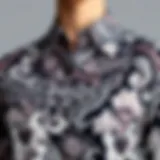Retro Work Dresses: Merging Style with Professionalism
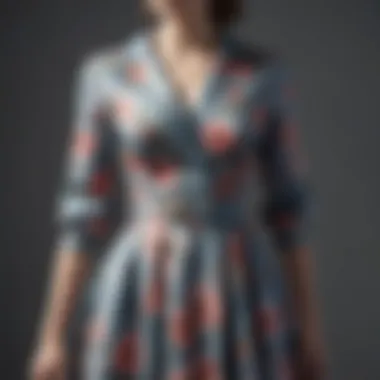

Intro
Retro work dresses have a unique spot in the fashion landscape. They beautifully merge elements of modesty and style, standing tall against the constantly shifting tides of current trends. For many, slipping into a retro work dress is like embracing a bit of history each day, while also conveying a sense of professionalism. These dresses offer an opportunity to express individuality even within strict workplace attire.
The charm of retro work dresses lies not solely in their aesthetic appeal but also in how they symbolize a brave sense of identity. As we journey through the realms of fashion, tradition and modernity often collide. Retro styles, embracing classic designs with a touch of contemporary flair, hold strong in today’s professional environments, making them relatable for a wide audience, from designers and retailers to students and influencers.
Foreword to Retro Work Dresses
Retro work dresses hold a charm that extends far beyond their stylish cuts and patterns. They capture a unique synthesis of modesty and aesthetics, a testament to various decades that have creatively shaped women's styles through the years. This section aims to shed light on why these dresses remain relevant today, presenting an invitation to both designers and everyday fashionistas to embrace their rich histories while incorporating them into modern work environments.
Definition and Historical Context
At first glance, a retro work dress might seem simply like any classic dress, but its definition is steeped in rich fashion history. Typically, retro work dresses are those that draw inspiration from styles spanning from the 1920s to the 1970s. They often flaunt fitted shapes, playful prints, and fabrics that prioritize both function and flair. Over decades, different eras have contributed varied elements, encapsulating cultural shifts along the way.
For instance, the 1920s introduced looser silhouettes with dropped waists, aligning with women’s burgeoning freedom. In the 1950s, fit-and-flare styles emerged, reflecting shifts in societal norms and women re-entering the workforce post-World War II. Each period offers not only a glimpse into the fashion trends of the time but also serves as a mirror, reflecting broader cultural changes and women's roles within society.
The Significance of Retro Styles in Fashion
The significance of retro styles in today’s fashion landscape cannot be discounted. They provide a lineage of styles, showing how tastes evolve yet remain interconnected. The resurgence of retro work dresses aligns with the current trend towards sustainable and eco-conscious fashion. Buying vintage or vintage-inspired clothing, such as a sweet polka dot dress with a thoughtful A-line silhouette, gives a second life to garments that might otherwise fade into obscurity.
Beyond sustainability, retro work dresses offer a means of personal expression for women navigating present-day professional settings. They can spark conversation and inspire creativity in a world often dominated by neutral, utilitarian attire. Moreover, these dresses serve as a bridge, connecting generations of women who appreciate the time-tested quality and charm of earlier fashions. From the busy office to a casual meeting, retro dresses turn heads and showcase a refined yet playful sense of style.
"Fashion is a form of self-expression, showcasing the intricate tapestry of our history, culture, and individuality."
The journey of retro work dresses encapsulates a rich tapestry of styles, each bearing witness to a time that prioritized both grace and empowerment. As we unfold the layers of this topic throughout the article, it becomes clear that these dresses are not just remnants of what once was, but rather, active players in shaping today’s fashion narrative.
Key Characteristics of Retro Work Dresses
Key characteristics of retro work dresses are what set them apart from contemporary styles. These elements define not only their aesthetic but their practicality and versatility. In a world where fashion trends can come and go with the wind, understanding these characteristics provides insight into why retro work dresses hold their own in modern wardrobes.
Silhouette and Cut
The silhouette of a dress plays a significant role in its overall appeal, especially in the context of retro work dresses. Designers historically favored shapes that complimented various body types while maintaining a sense of modesty. Take, for example, the tea-length dresses of the 1950s. They feature a fitted bodice with a flared skirt, creating a classic hourglass shape. This silhouette not only accentuates the waist but also allows freedom of movement, making it practical for a busy work environment.
Additionally, the A-line shape emerges as another hallmark. It skims over the hips and gradually widens towards the hem, offering comfortable wear without sacrificing elegance. Layering becomes an integral aspect, as these dresses can be easily paired with belts or cardigans, enhancing their versatility in professional settings. To embrace the vintage charm while ensuring a polished look, the right cut must be considered.
Fabrics and Materials
When we talk about fabrics and materials, retro work dresses often showcase a rich variety that breathes life into their designs. Materials like cotton, wool, and silk have historically been favored for their durability and comfort, while also exuding an air of sophistication. Cotton is particularly cherished for its breathability, making it suitable for long hours at the office. Wool, on the other hand, may be associated with autumnal hues and heavier styles, providing warmth without compromising style.
Sustainable fabrics are also starting to arise in contemporary designs, resonating with eco-conscious consumers. Fabrics such as organic cotton or recycled polyester not only reflect modern values but also pay homage to the classic styles that have stood the test of time. The choice of fabric plays a critical role; it affects how the dress drapes, moves, and ultimately, how it’s perceived in a professional context.
Color Palettes and Patterns
Color and pattern can radically transform a retro work dress, offering an array of options suitable for a range of professional environments. Typically, a retro aesthetic tends to incorporate a palette of muted or pastel colors. Think of the soft pinks, powder blues, and mint greens that were so popular in mid-century fashion. These hues are calming and can project a sense of professionalism without being too stark.
Patterns also significantly contribute to the retro charm. Polka dots, florals, and plaids invite a sense of joy and nostalgia, often evoking the spirit of the eras they represent. When selecting a retro work dress, one might consider the occasion; subtle patterns might work better in conservative environments, while bolder designs can express individuality in more relaxed settings.
"Fashion is made to become unfashionable." — Coco Chanel
Understanding these key characteristics is essential for anyone looking to integrate retro work dresses into their wardrobes. The nuances of silhouette and cut, the selection of fabrics and materials, along with the thoughtful choice of colors and patterns contribute to an enduring style that's both modern and classic.
Major Eras Influencing Retro Work Dresses
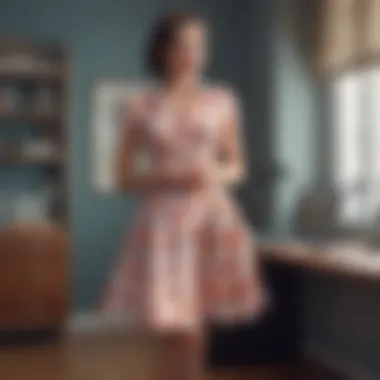

Understanding the major eras influencing retro work dresses is key to grasping their lasting impact on contemporary fashion. These periods not only shaped the aesthetics of these garments but also highlighted the social and cultural shifts of their times. Looking into the roaring twenties, the post-war fifties, and the groovy seventies offers a window into how work attire evolved alongside societal changes. Retro work dresses serve as a tapestry interwoven with history, attitude, and a touch of rebellion, resonating with women who value both style and substantial expression in their wardrobes.
The Roaring Twenties
The roaring twenties was a decade defined by exuberance and transformation. Women sought to break free from the constraints of previous eras, and fashion reflected this newfound freedom. The shift from restrictive garments to more practical and stylish options marked a significant change. Flapper dresses, often featuring dropped waistlines and loose-fitting styles, started to emerge as a staple in women's attire.
In the workplace, the arrival of these dresses introduced a sense of individuality and modernity. The use of lighter materials such as silk and chiffon also added flow and movement, adapting well to various work settings. This era was characterized by bold patterns and vibrant colors, which worked very well in the lively social scene of the time. Women wearing these dresses made statements both in and out of the office, challenging the traditional roles assigned to them.
In this regard, the roaring twenties can be viewed as a vital era that influenced how modesty and style could coexist in professional environments.
The Post-War Fifties
Following the tumultuous years of World War II, the fifties ushered in an era of recovery and stability. The fashion world saw a return to femininity, which for many ladies meant embracing the hourglass silhouette promoted by designers like Christian Dior. The New Look, characterized by cinched waists and full skirts, became emblematic of this time.
For women re-entering the workforce, the fifties offered a unique challenge. The retro work dress of the time often combined practicality with the broad appeal of femininity. Fabrics like cotton and wool blends became popular, providing both comfort and elegance. The prints and colors of the fifties tended to be softer, focusing on pastels that conveyed both professionalism and flair.
Women wearing these retro designs exuded a confident charm, effortlessly blending modesty with style. The post-war fifties underscored that a professional working woman could express herself through her clothing while making a statement about equality and capability.
The Groovy Seventies
Ask anyone about the seventies, and chances are they will share images of vibrant colors and a sense of freedom. The decade brought with it an ethos of self-expression through fashion, leading to innovations that would influence retro work dresses significantly. The fabrics of this era shifted towards more durable and versatile materials like polyester, which allowed for bold and flamboyant designs, while still being practical.
In workplaces, the reflectiveness of the groovy sixties-style led to experimentation with patterns like paisley, floral designs, and stripes. The introduction of the maxi dress, offering freedom of movement, became a stylish choice for those looking to embody the spirit of the times. Additionally, platform shoes began to make their mark, allowing women to combine a casual aesthetic with elegance.
Contemporary Interpretations of Retro Work Dresses
In today’s fashion landscape, retro work dresses are having quite a moment. They blend modesty with a unique flair, creating pieces that speak to more than just nostalgia; they echo a time when fashion was as much about character as it was about cut. This section will explore the contemporary interpretations of these classic designs and their relevance in modern workplaces.
Modern Designers Embracing Retro Aesthetics
When you think of retro work dresses, it’s easy to conjure up images of old-school tailoring; however, numerous modern designers are giving old styles a vigorous punch. For instance, brands like Milly and Shoshanna have successfully incorporated vintage silhouettes into their collections. Their modern takes often include higher waistlines and even asymmetrical patterns that cater to youthful consumers while maintaining classic charm.
What’s captivating is the meticulous attention to detail some designers implement. Intricate stitch work, bold color blocking, or unexpected prints can invigorate what was formerly regarded as outdated. An example here is the use of playful polka dots combined with structured cuts, which not only delight the eye but also remain workplace appropriate.
These designers bring a sense of playfulness to their collections, with pieces that suit many professional settings while allowing for individual expression. Embracing retro aesthetics does not merely serve a cosmetic purpose but also demonstrates a broader understanding of sartorial history – each dress carries a story through its style.
Retrofuturism: Blending Past and Present
Retrofuturism embodies the spirit of linking past styles with future innovations. This movement pulls diverse elements from history and reinterprets them in new, exciting ways. Think of the high collars and flared skirts of yesteryears, now made from innovative fabrics that offer comfort and breathability. Designers are experimenting with technology, layering traditional forms with modern materials like breathable jersey blends and eco-friendly fibers.
A brilliant example of this is Diane von Furstenberg, who often combines her classic wrap dress with contemporary prints and materials, making it suitable for various occasions—from board meetings to weekend brunch. The beauty of retrofuturism lies in its ability to nod to history without being stuck in it.
Here’s a look at some key aspects of retrofuturism in fashion:
- New Materials: Incorporating technical fabrics that were unthinkable in the past adds a new twist.
- Color and Print Innovation: Updating classic patterns with fresh colors or unexpected designs provides a modern edge.
- Technology Integration: Using tech to produce fabrics can create clothes that are not only stylish but also functional.
This blend of eras creates a rich tapestry of options for today’s professional woman, allowing for self-expression while adhering to workplace standards. As this trend continues developing, it’s likely we will see even more imaginative designs emerge from various designers.
"Fashion is not just about clothing; it's about identity and how we choose to present ourselves in both the workplace and life."
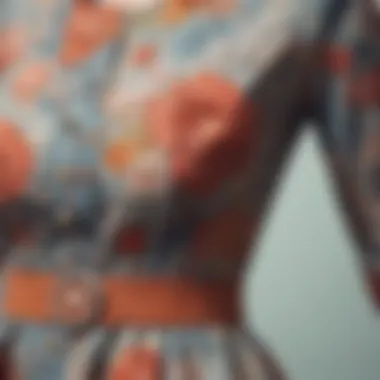

In summary, contemporary interpretations of retro work dresses showcase how the fashion world can evolve yet retain its roots. Through the innovation of modern designers and the retrogenerative spirit of retrofuturism, we see a delightful merging of the old and new that resonates with personal expression for the modern professional.
Styling Retro Work Dresses for Today's Professional Women
Styling retro work dresses in the current professional landscape is indeed an intricate ballet of fashion and purpose. While some might think of these dresses as mere relics of a bygone era, they actually embody a harmonious blend of aesthetics and functionality. Today's professional women are increasingly embracing this unique intersection of vintage charm and modern sensibility.
When thought of properly, retro work dresses bring an opportunity to showcase individuality while also adhering to the often-unwieldy framework of corporate dress codes. They can convey professionalism without sacrificing personal style, allowing women to express themselves in environments that can sometimes feel uniform and stifling.
Layering Techniques
Layering is a vital skill in crafting an effortlessly chic look with retro work dresses. It serves more than just warmth; it adds depth and sophistication. A fitted blazer, for instance, can seamlessly elevate a cotton swing dress, lending a tailored appearance suitable for meetings. Consider a textured cardigan or even a light turtleneck underneath a sleeveless retro dress to add that extra layer of interest.
Mixing patterns can also be a fun challenge. If the dress has a floral design, a striped blazer can provide contrasts without being too overwhelming.
- Choosing the Right Outerwear: A blazer that complements the dress’s color palette can polish the outfit.
- Length Matters: Longer cardigans can provide a relaxed feel, while structured jackets create a more authoritative vibe.
These layering choices demonstrate an understanding of fashion's rhythm, enabling women to transition smoothly from day meetings to evening events, all while staying stylish.
Accessorizing with Purpose
Accessorizing retro work dresses offers a rich tapestry of possibilities. Choosing the right accessories can amplify the impression a woman makes. Statements like pearl earrings or a vintage watch not only reflect sophistication but also offer glimpses into personal style narratives.
Rethink all those commonly accepted norms when it comes to accessories.
- Belts: A cinched waist can redefine silhouettes while injecting additional color or texture. A bold belt can add modernity to a classic piece.
- Bags: Opt for structured handbags for a classy feel, or playful clutches for more casual settings.
- Jewelry: Minimalist pieces such as a delicate chain can provide a clean line, while chunkier necklaces can make a pronounced statement.
"The choice of accessorizing can transform the whole feel of a retro work dress: From boardroom to banquet, it's all in the details."
The right accessories create a dialogue with the outfit. They tell a story that goes beyond the fabric, reflecting the wearer's personality and confidence.
Footwear Choices for a Polished Look
Footwear is where functionality meets fashion head-on. The shoes chosen to complement a retro work dress can make or break the ensemble. Comfort and style must coalesce, particularly when navigating busy days.
Classic choices include:
- Kitten heels or pumps: Perfect for elongating the legs while providing adequate support.
- Loafers: For a more relaxed yet polished look, especially in conservative environments.
- Ankle boots: Adds a trendy edge to the overall outfit, suitable for a casual Friday.
Balance is key.\ Avoid overly casual footwear like flip-flops, even if they scream comfort. Instead, consider prioritizing shoes that have an aura of professionalism while not sacrificing comfort.
In summation, styling retro work dresses for today's professional woman is an art form that combines durability and elegance. Layering, purposeful accessorizing, and mindful footwear choices all contribute to a polished appearance, enabling individuals to navigate diverse work environments with grace. With the right approach, retro work dresses can become truly versatile assets in any professional wardrobe.
Challenges and Considerations
When it comes to embracing retro work dresses, there are numerous hurdles professionals must navigate. Staying stylish while adhering to an office's dress code can sometimes feel like walking a tightrope. Balancing individuality with conformity is no small feat, especially in corporate environments that often lean toward the conservative. Understanding these challenges is crucial for anyone looking to incorporate retro styles into their work wardrobe.
Navigating Office Dress Codes
Office dress codes can be a mixed bag; some workplaces embrace creativity, while others stick strictly to traditional attire. Retro work dresses, while often stylish and chic, can sometimes straddle that thin line between appropriate and informal. Each office has its own unwritten rules, which necessitates a keen understanding of what is acceptable in that specific environment.
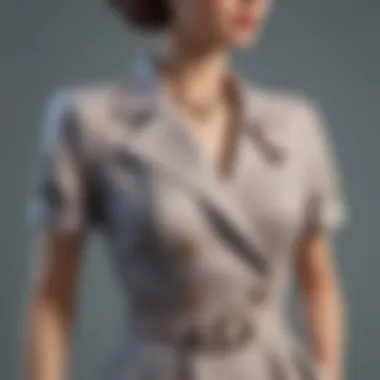

For instance, a classic 1950s-inspired dress with a modest neckline and knee-length hemline might fit well within a creative firm like an advertising agency. In contrast, that very same dress could raise eyebrows in a corporate legal office, where suits dominate. It’s essential to do a bit of sleuthing, so to speak, into the company’s culture when picking out outfits for work. Here are few pointers to help navigate this:
- Observe Colleagues: Take notice of what co-workers wear. It’s often a good indicator of what’s acceptable attire.
- Opt for Subtle Prints: If the dress has a retro flair but remains subtle in print or color, it might be more likely to fit within your office's dress code.
- Layer Smartly: Wearing a blazer or cardigan over a retro dress can make it look more professional, helping to balance personal style with workplace requirements.
Balancing Comfort with Style
No one wants to spend their workday fidgeting with an outfit that feels uncomfortable. Retro work dresses are often praised for their flattering silhouettes; however, they can sometimes sacrifice comfort for style. Striking a balance between the two is key.
Here's how to keep comfort in check while staying stylish:
- Choose the Right Fabric: Look for materials that have a bit of stretch. Cotton blends or fabrics with a touch of spandex can make movement much easier while still holding a classic shape.
- Consider Dress Length: While some may think that a floor-length retro dress is all the rage, practicality is important. A tea-length dress often provides both elegance and ease.
- Mind the Fit: A tailored dress that fits just right is not only flattering but also comfortable. When a dress fits like a glove, it allows greater freedom to focus on work instead of adjusting clothing.
Remember that comfort can significantly impact productivity. If your attire makes you feel at ease, you are more likely to bring your best self to the office. Being confident in your appearance often translates into a more positive attitude throughout the workday.
"The best attire is one that speaks to you without compromising your ethos at work."
Navigating through the challenges of office dress codes while balancing comfort with style might seem daunting. However, with thoughtful choices and a bit of creativity, retro work dresses can not only meet expectations but also allow for personal expression in professional spaces.
The Future of Retro Work Dresses
The landscape of fashion is constantly shifting, but retro work dresses remain a compelling focal point for both designers and enthusiasts. As we look ahead, it’s crucial to explore how these dresses can adapt to the evolving demands of societal expectations and consumer preferences. With a renewed emphasis on sustainable practices and cultural relevance, the future of retro work dresses is poised to be a blend of tradition and innovation, offering a unique opportunity for self-expression in professional settings.
Sustainability and Retro Fashion
The conversation around sustainability in fashion is growing louder, and retro work dresses are not immune to this trend. As awareness about environmental impact increases, consumers are seeking garments that align with their values. Retro dresses, often characterized by quality materials and timeless designs, lend themselves well to sustainable practices.
Now, more than ever, brands are focusing on sourcing eco-friendly fabrics and employing ethical production methods.
- Recycled Materials: Some designers are utilizing recycled textiles to create new pieces, ensuring that the essence of vintage styles is preserved while reducing waste.
- Local Production: Companies are moving towards local manufacturing to decrease carbon footprints, giving a nod to retro design's origins and helping to support local economies.
- Quality Over Quantity: The embrace of slow fashion principles means that consumers are more likely to invest in a well-made, retro-inspired work dress that stands the test of time. This shift helps counteract the throwaway culture that often dominates fast fashion.
"Fashion is fleeting, but style is eternal. Retro work dresses embody this ethos, promising longevity in both wear and environmental impact."
Cultural Influences on Future Designs
Cultural trends have always played a significant role in shaping fashion, and it's no different when it comes to retro work dresses. As global connectivity increases, diverse cultural influences are bound to make their mark on future designs. Today’s designers are looking to infuse elements from various cultural heritages into their retro interpretations:
- Global Aesthetics: Integrating fabrics and motifs from various cultures could become commonplace. Imagine a classic ‘50s cut dress adorned with intricate embroidery inspired by traditional Asian artistry.
- Inclusivity in Design: There’s growing recognition that fashion should cater to all body types and identities. This means that future retro work dresses may feature more varied sizing, cuts, and styles that reflect a deeper understanding of societal norms.
- Narratives in Fashion: The stories behind the designs, focusing on the craftsmanship and historical context, can add depth to the garments. This trend pushes consumers not just to wear vintage looks but also to appreciate their background and significance.
By forging connections between the past and present, retro work dresses can remain relevant while addressing the concerns and desires of future generations in our fashion-forward society.
Culmination
The discussion around retro work dresses culminates in understanding their enduring legacy and significance in fashion today. Not only do these dresses offer a unique blend of style and modesty, but they also serve as a canvas for personal expression in the contemporary workplace. The past influences the present in a beautiful tapestry that we can witness in local boutiques, upscale department stores, and even thrift markets.
The Enduring Legacy of Retro Work Dresses
In the labyrinth of fashion history, retro work dresses stand out like treasures from a bygone era. They are more than mere garments; they embody values of elegance, empowerment, and individuality. One can argue that the whisper of vintage aesthetics carries a weight that modern fast fashion often overlooks.
These dresses, inspired by the iconic styles of the 1920s to the 1970s, often feature elements such as high waistlines, cinched silhouettes, and playful prints. They remind us that workwear does not have to sacrifice personality for professionalism. Here are some key advantages and insights:
- Timelessness: The classic cuts and designs evoke nostalgia while remaining adaptable to changing trends. They often make a graceful return, marking their significance in fashion cycles.
- Versatility: Retro work dresses can be dressed up or down, transitioning from office environments to after-work socials seamlessly. Pairing them with blazers or chunky knits can create a whole new look.
- Cultural Resonance: Each era has its own cultural backdrop, influencing the patterns and styles of dresses. For instance, a floral print in a shift dress might remind one of the liberating spirit of the 1960s.
- Sustainability: With growing awareness around fast fashion, retro styles encourage a shift toward sustainability, promoting investment in quality pieces over transient ones.
"Fashion fades, only style remains the same." - Coco Chanel. This quote rings true when reflecting on the enduring nature of retro work dresses. They symbolize a conscious refusal to compromise on artistic expression, regardless of the workplace setting.
In navigating today's multifaceted professional landscape, embracing retro work dresses offers an opportunity for women to assert their identity while adhering to modern dress codes seeking modesty and style. In a world that often champions uniformity, retro styles serve as a reminder of the beauty found in individuality, proving they are not just clothing but rather a form of expression that resonates with the rhythms of history.
